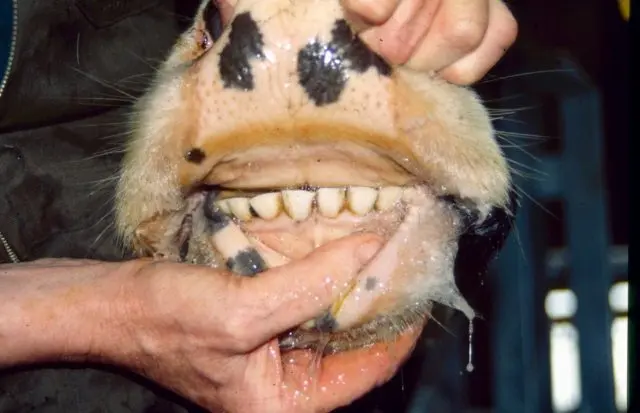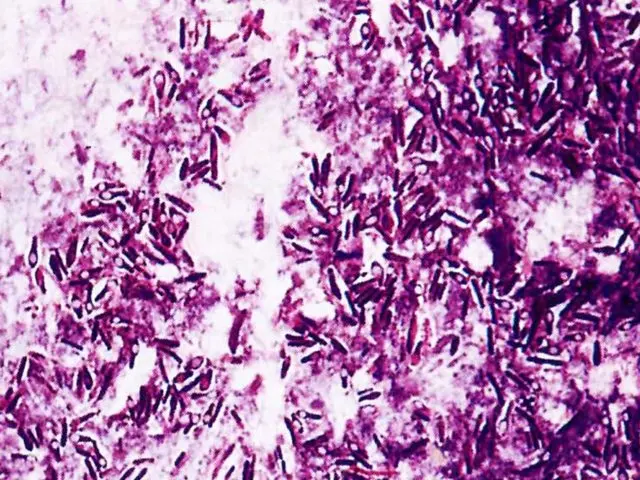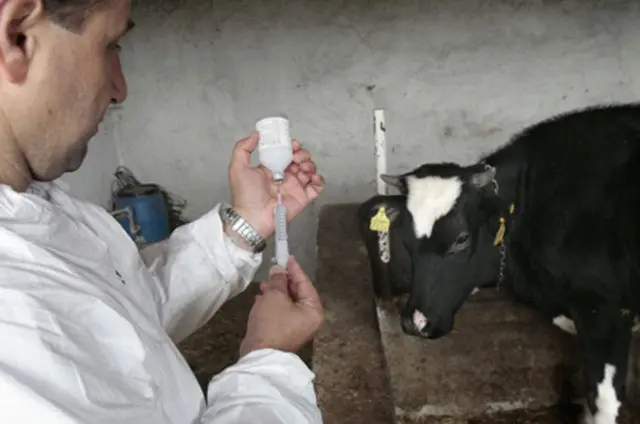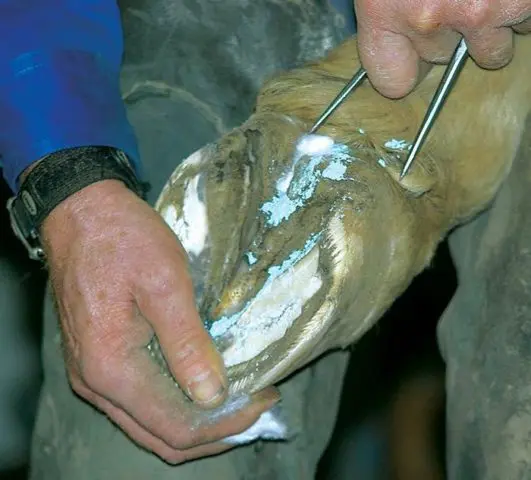Contents
Necrobacteriosis of cattle is a fairly common disease in all areas and regions of the Federation where animal husbandry is practiced. Pathology causes serious economic damage to farms, since during the period of illness, cattle lose milk productivity and up to 40% of body weight. Agricultural animals and humans are susceptible to necrobacteriosis. The disease is recorded most often in breeding, fattening farms and is characterized by damage to the limbs. The main cause of this disease in cattle is a violation of veterinary, sanitary and technological standards. It can occur in acute, chronic and subacute form.
What is necrobacteriosis

Inspection of the oral mucosa of cattle
Necrobacteriosis of cattle has another name – panaritium of cattle. The disease is infectious, characterized by a purulent lesion and necrosis of areas in the area of the hoof, the interhoof gap, and also the corolla. Sometimes the udder, genitals, lungs and liver are affected. In young individuals, necrosis of the mucous membranes in the mouth is often observed.
In the absence of competent therapy and a weak immune system of the animal, the disease becomes more serious within a few weeks. Bacteria multiply quite quickly, penetrating into internal organs and tissues, causing severe intoxication in the body of cattle.
Necrobacteriosis of cattle began to spread actively in farms in the early 70s after the arrival of a large batch of breeding individuals on the territory of the former USSR. Until today, veterinary specialists are doing everything possible to prevent the disease from spreading so actively. It is believed that leg infections are the biggest threat to dairy farms, as only a healthy cow can produce high milk yields. This requires good, strong limbs in order to actively move. With pain in the legs, individuals eat less, move, thus, milk production is significantly reduced.
The causative agent of necrobacteriosis in cattle
The causative agent of bovine necrobacillosis is an immobile toxin-forming anaerobic microorganism. A comfortable habitat for him is the digestive tract of livestock. Upon contact with oxygen, it instantly dies. In the affected tissues and organs, the bacterium forms long colonies; single microorganisms are less common.

The causative agent of necrobacteriosis in cattle
The causative agent is divided into 4 types, of which serotypes A and AB are the most pathogenic. In the process of life, they form toxic compounds that are involved in the development of the disease. The bacterium dies, losing its pathogenic effect:
- while boiling for 1 minute;
- under the influence of sunlight – 10 hours;
- under the influence of chlorine – half an hour;
- in contact with formalin, alcohol (70%) – 10 minutes;
- from caustic soda – after 15 minutes.
Also, the necrobacteriosis bacterium is sensitive to antiseptics such as lysol, creolin, phenol, drugs from the tetracycline group. For a long time, the pathogen is able to remain viable (up to 2 months) in the ground, manure. In moisture, the bacterium lives up to 2-3 weeks.
Sources and routes of infection
The causative agent of infection in cattle enters the environment with various secretions of individuals – feces, urine, milk, mucus from the genitals. Infection occurs by contact. Microorganisms enter the body of cattle through the wound surface on the skin or mucous membranes. The danger is caused by individuals with a pronounced clinical picture of the disease and recovered animals.
Usually, the disease is registered on the farm after the importation of a batch of livestock from a dysfunctional farm, without observing a 30-day quarantine. Further, necrobacteriosis is periodic in nature with an exacerbation in the autumn-spring season, especially if feeding and living conditions worsen. In addition, the following factors have a great influence on the development of the disease:
- untimely cleaning of manure;
- low-quality floor in the barn;
- no hoof trimming;
- high humidity;
- skin parasites and other insects;
- injuries, wounds;
- decrease in body resistance;
- walking in wetlands;
- lack of veterinary, zootechnical measures in farms and farms.
In the body of cattle, the infection spreads with blood flow, so secondary areas of damage are formed in the tissues, and necrosis develops in the heart, liver, lungs, and other organs. As soon as the disease passes into this form, the prognosis becomes more unfavorable.
Symptoms of necrobacillosis of cattle
Without an examination by a veterinarian, it is difficult to recognize the manifestations of the disease, because the symptoms of necrobacteriosis in the body of cattle are also characteristic of a number of other pathologies.

The defeat of the limbs of cattle with necrobacteriosis
Common symptoms of an infection include:
- lack of appetite;
- oppressed state;
- low productivity;
- limitation of mobility;
- loss of body weight;
- foci of purulent lesions of the skin, mucous membranes, limbs of cattle.
With necrobacillosis of the limbs (photo), the individual of the cattle picks up his legs under himself, limps. Inspection of the hooves shows swelling, redness, purulent discharge is observed. At the first stage of the disease, necrosis has clear boundaries, then the lesions expand, fistulas and ulcers form. There is severe pain on palpation.
The skin is most often affected in the neck, limbs above the hooves, genitals. It manifests itself in the form of ulcers and abscesses.
With the development of necrobacteriosis in cattle on the mucous membranes, the mouth, nose, tongue, gums, and larynx suffer. On examination, foci of necrosis, ulcers are visible. In infected individuals, increased salivation occurs.
Necrobacteriosis of the udder of cattle is characterized by the appearance of signs of purulent mastitis.
With necrobacillosis of cattle, necrotic formations appear in the stomach, lungs, and liver from the internal organs. This form of the disease is the most severe. The prognosis of the disease is unfavorable. The animal dies after a couple of weeks from exhaustion of the body.
Necrobacteriosis proceeds differently in mature cattle and young animals. In adult animals, the incubation period can last up to 5 days, and then the disease becomes chronic. In this case, the infection is difficult to treat. Sometimes bacteria begin to spread through the lymphatic system, resulting in gangrene or pneumonia.
The incubation period in young individuals lasts no more than 3 days, after which the pathology becomes acute. Young animals have severe diarrhea, which leads to rapid dehydration. As a rule, the cause of death is blood poisoning or exhaustion.

Vaccination of cattle against necrobacteriosis
Diagnosis of necrobacteriosis in cattle
Diagnosis is carried out in a complex manner, taking into account epizootological data, clinical manifestations, pathoanatomical changes, as well as using laboratory tests according to the instructions for cattle necrobacteriosis. The diagnosis can be considered accurate in several cases:
- If, when laboratory animals are infected, they develop necrotic foci at the injection site, as a result of which they die. In smears, a culture of the pathogen is detected.
- When determining a culture from pathological material with subsequent infection of laboratory animals.
When conducting a differential analysis, it is important not to confuse the infection with such diseases as brucellosis, plague, pneumonia, tuberculosis, foot and mouth disease, aphthous stomatitis, purulent endometritis. These pathologies have similar clinical manifestations with necrobacteriosis. In addition, veterinarians should exclude laminitis, dermatitis, erosion, ulcers and hoof injuries, arthritis.
After the recovery of animals, the development of immunity to necrobacteriosis in cattle was not detected. For immunization, a polyvalent vaccine against bovine necrobacteriosis is used.
All types of laboratory research are carried out in several stages. Initially, scrapings are taken from infected tissues, mucous membranes. In addition, they collect urine, saliva, swabs from the genitals.
The next step will be the isolation and identification of the causative agent of necrobacteriosis. The final stage involves some research on laboratory animals.
Pathological anatomical changes in dead individuals with necrobacillosis of the extremities in cattle suggest purulent arthritis, accumulation of exudate in muscle spaces, tendovaginitis, abscesses of various sizes, phlegmonous formations, and foci of necrosis in the femoral muscles. With necrobacteriosis of organs, abscesses containing a purulent mass, necrosis are found. Pneumonia of a purulent-necrotic nature, pleurisy, pericarditis, peritonitis are noted.

Necrobacteriosis of the skin of cattle
Treatment of bovine necrobacillosis
Immediately after the diagnosis of necrobacillosis should begin treatment. First of all, the infected animal must be isolated in a separate room, the affected areas should be chemically cleaned with the removal of dead tissue. Wash the wounds with a solution of hydrogen peroxide, furacillin or other means.
Since the bacterium creates a kind of barrier between the vessels and infected tissues, the penetration of drugs is very difficult. That is why antibiotics in the treatment of necrobacteriosis in cattle are prescribed in slightly overestimated dosages. The most effective drugs include:
- erythromycin;
- penicillin;
- ampicillin;
- chloramphenicol.
Antibacterial agents for topical application, for example, aerosol antibiotics, show a positive effect. They are used after dry cleaning of hooves.
Group therapy based on regular foot baths is widely used. Containers are installed in those places where the animal most often moves. The composition of the bath includes disinfectants.
The scheme for the treatment of necrobacillosis in cattle is made by a veterinarian, based on the studies. Further, he can change therapeutic measures depending on changes in the condition of sick cattle.
Since bovine necrobacillosis is a contagious disease for humans, the slightest possibility of infection must be excluded. To do this, farm employees need to know and follow the basic rules of personal hygiene, use overalls and gloves while working on the farm. Wounds on the skin should be treated with antiseptics in a timely manner.
Preventive measures

Treatment of cattle hooves
Treatment and prevention of cattle necrobacteriosis should also include the improvement of the entire economy where the disease was detected. You must enter quarantine mode on the farm. During this period, you can not import and export any livestock. All changes in maintenance, care, nutrition must be agreed with the veterinarian. Sick cows and those with suspected necrobacillosis are isolated from healthy ones, a treatment regimen is prescribed, the rest are vaccinated. Every 7-10 days, all livestock must be driven through special corridors with disinfectant solutions in containers.
For the slaughter of cattle, it is necessary to prepare special sanitary slaughterhouses and obtain permission from the veterinary service. Carcasses of cows are burned, you can also process them into flour. Milk is allowed to be used only after pasteurization. Remove the quarantine a few months after the cure or slaughter of the last infected animal.
Common preventive measures include the following:
- the herd must be completed with healthy individuals from prosperous farms;
- arrived cows are quarantined for a month;
- before introducing new individuals into the herd, they must be driven through the corridor with a disinfectant solution;
- daily cleaning of the barn;
- disinfection of the premises 1 time in 3 months;
- hoof treatment 2 times a year;
- timely vaccination;
- balanced diet;
- vitamin supplements and minerals;
- regular inspection of animals for injuries.
Also, to prevent the development of necrobacteriosis, it is necessary to normalize the content of animals. Premises should be cleaned of manure in a timely manner, the flooring should be changed to avoid injuries.
Conclusion
Necrobacteriosis in cattle is a complex systemic disease of an infectious nature. The risk group includes, first of all, young cattle. In the initial stages of the disease, with a competent treatment regimen compiled by a veterinarian, the prognosis is favorable. Necrobacteriosis is successfully avoided by farms actively involved in prevention.









